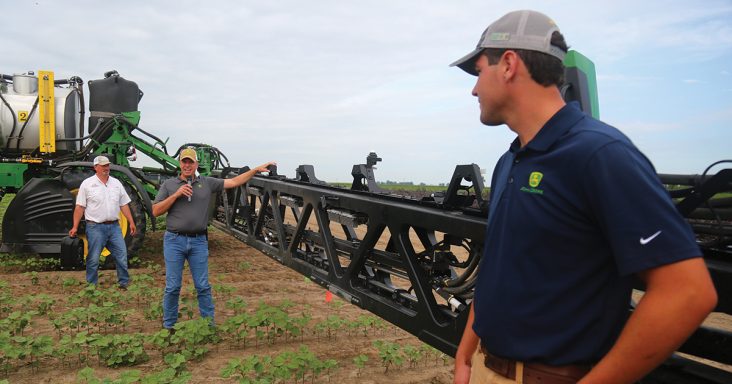Savings noted with university testing of ‘See & Spray’ herbicide system
by May 7, 2025 10:00 am 516 views

Courtesy University of Arkansas System Division of Agriculture/Ryan McGeeney. Division of Agriculture weed science researchers Jason Norsworthy and Tom Barber, along with representatives from John Deer and Blue River Technologies, host a demonstration of the See & Spray Ultimate herbicide spraying system.
Precision agriculture or farming is a methodology within the industry that seeks new technologies to increase crop yields by lowering the levels of traditional inputs — land, water, fertilizer, herbicides and insecticides — needed to grow crops, according to Sustainable America (SA).
GPS devices on tractors, for instance, allow farmers to plant crops in more efficient patterns and proceed from point A to point B with more precision, saving time and fuel.
Fields can be leveled by lasers, which means water can be applied more efficiently and with less farm effluent running off into local streams and rivers. The result can be a boon for farmers and holds great potential for making agriculture more sustainable and increasing food availability, according to SA.
Three years ago, researchers from the Arkansas Agricultural Experiment Station began a trial using the John Deere developed See & Spray system on soybeans. The research showed that using the technology could cut post-emergence herbicide use in half. The technology could potentially save Arkansas farmers millions of dollars a year.
Arkansas soybean producers could expect herbicide cost savings ranging up to 80%, which would net up to $48 million per year on post-emergence herbicide expenditures in Arkansas, the study noted. The system uses machine learning combined with real-time imagery from cameras to selectively spray herbicide on weeds in row crops. There are more than a dozen companies with interests in targeted spraying technology, including the system from John Deere, according to Farm Progress.
See & Spray uses visual recognition and machine learning to selectively spray pesticides in crop fields rather than broadcasting chemicals over an entire area. A series of digital cameras mounted on 120-foot booms affixed to a tractor are used to identify and spot-spray weeds.
The original concept was developed by Blue River Technology in California to thin lettuce fields to an ideal plant population. When John Deere acquired Blue River about eight years ago, the concept was expanded to identify and eradicate weeds in row crop agriculture.
Jason Norsworthy, professor of weed science for the experiment station, has evaluated the system in test plots at the Northeast Research and Extension Center in Keiser since 2017 as part of his broader research on weed management in Arkansas crops and the growing resistance of agricultural weeds to existing herbicide chemistries.
The results of the field trial indicate the system can offer a short return on investment at the lowest sensitivity setting and allows for up to 59% reduction in herbicide use compared to broadcast applications, in which herbicide is applied across an entire field.
“When a grower lowers the sensitivity setting, only larger weeds are sprayed, which will result in a reduction in herbicide use in the short term,” Norsworthy said. “However, when subsequent applications within a year are made, those pigweeds missed with the first application could not be controlled in the follow-up application. These escapes produced seed, resulting in an increase in the soil seed bank.”
During the field trial, operating at a low sensitivity setting increased the Palmer amaranth pigweed population by 280% each year.
Researchers observed a slight yield increase of about four bushels of soybean per acre likely the result of reduced injury to soybean plants from herbicide applications, but it came with a significant increase in pigweed.
For the study that began in 2022, Norsworthy used a See & Spray prototype to measure the year-to-year effects of using single-tank applications that apply post-emergence and pre-emergence herbicides, also known as residuals.
Norsworthy compared broadcast applications to targeted applications at the lowest and highest spray sensitivity settings. Efforts were prioritized on herbicide savings, weeds present and missed at application, reproductive weed escapes at harvest, and grain yield.
“All of my data would indicate that using the high-sensitivity setting is best in most scenarios,” Norsworthy said. “If the Ultimate is being used, the residual can be broadcast and the post-emergence herbicide can be targeted. If a Premium is used, the growers need to make multiple passes.”
Norsworthy said his previous studies have shown broadcasting residual herbicides was more effective in controlling weeds than targeting “and in most cases, there are subsequently more weeds present when the residuals are targeted.” At planting, residual herbicides ideally need to be broadcast, he added, “and then the post-emergence herbicide would be targeted.”
The See & Spray Ultimate can run at 15 mph but Norsworthy expects the speed to increase. The maximum speed for the Premium model is about 12 mph. Most of Norsworthy’s small-plot research was done at 8 to 12 mph since he said it is challenging to get a sprayer up to 15 mph without having extremely long fields.
Tristen Avent, a student in the crop, soil, and environmental sciences department, is working on economic analyses and breakeven points for the use of both the Premium and Ultimate models.
When assuming a $25,000 See & Spray upgrade cost from a comparable John Deere sprayer and incorporated applicator efficiency, Avent said the high sensitivity setting saved $30.49 per acre over the entire season and posed no increased risk relative to the broadcast method.
